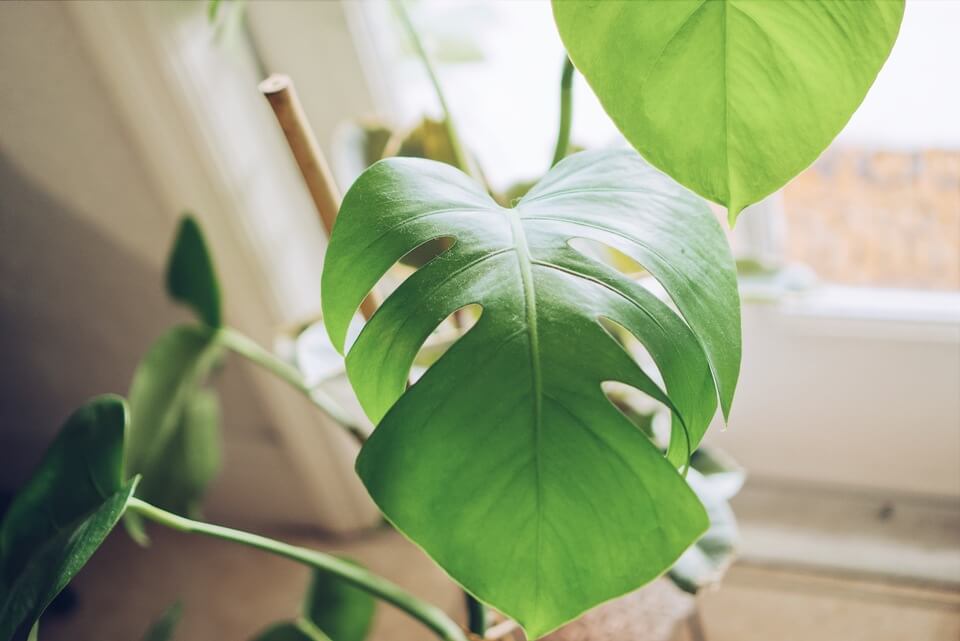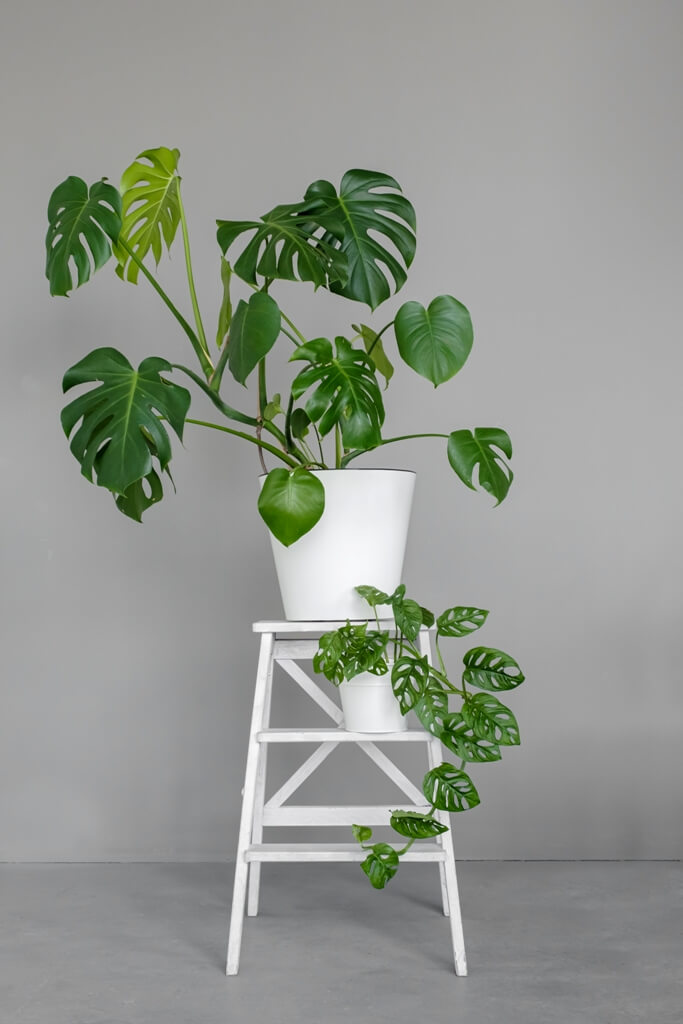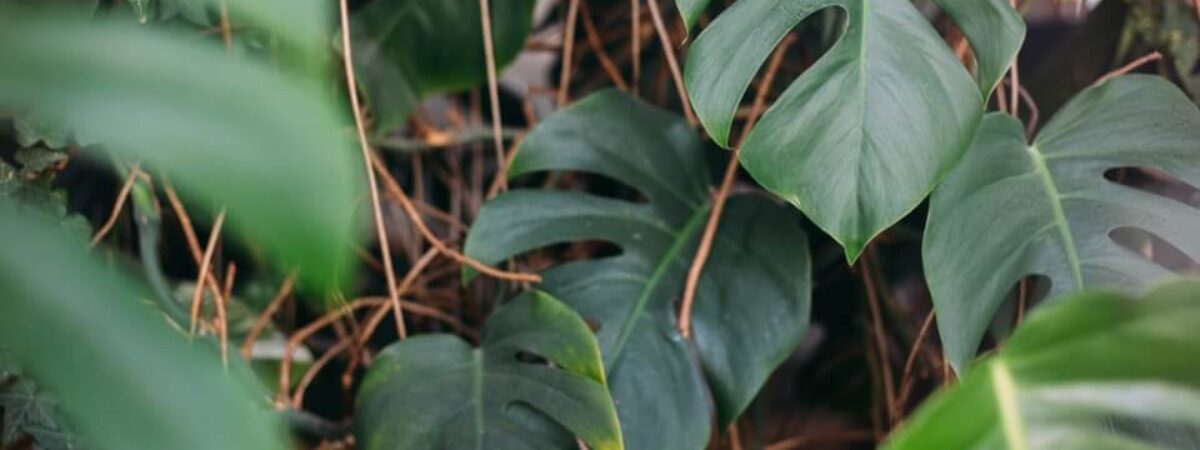Monstera deliciosa commonly called the Swiss Cheese plant is a tropical plant bearing fruit that grows in humid temperatures where there is no frost.
Monsteras originated from Mexico, Guatemala, Costa Rica, and south of Panama. They are part of the Araceae family and few of them produce edible fruits such as Monstera deliciosa.
Monstera deliciosa is also known as “split-leaf philodendron”. These are quite easy to grow houseplants that are evergreen vines and shrubs mainly found in Central America.
These plants have beautiful natural leaf holes that are called fenestrations for which they got their nickname as Swiss Cheese plant.
Although these are fruit bearing plants, when planted indoors as houseplants they don’t bear fruits rather they are characterized by glossy large heart shaped leaves with a split.
When they are young they act as table top plants and gradually become floor plants as they grow. They need more space widthwise.
Monstera deliciosa plant produces juicy edible fruit when planted outdoors. The fruit tastes somehow like a mix of banana and pineapple. They have tanned cream colored flowers that are pollinated by bees.
They can be grown in USDA hardiness zone 10 -12

Monstera deliciosa care
Light
Monstera deliciosa being an evergreen tropical plant prefers bright to medium indirect Sunlight. Click To TweetMonstera deliciosa being an evergreen tropical plant prefers bright to medium indirect Sunlight.
Too much direct Sunlight will burn the foliage but if you are growing it indoors, then expose the plant to direct light once a year to have better growth.
In case of variegated Monstera deliciosa they need proper Sunlight to retain their variegation. Since it has fenestrated leaves, it requires more Sunlight to split.
Water
Monstera deliciosa needs medium moisture, hence watering is required everyday during its growing season. Always allow the soil to completely dry out before next watering.
During summer and spring months they need frequent watering whereas during winters less watering is required.
Monsteras possess thick roots, so over watering may lead to root rot that may become fatal for the plants.
Soil
Monstera deliciosa prefers soils that are light sandy, loamy, or heavy clay, where the pH is a little acidic or neutral. The soil must be well drained and a little moist.
If grown indoors, the soil in the pot should be peat based that has good drainage facility and can retain moisture required for the plant. Mix perlite with soil to have good soil aeration.
Humidity
As Monstera deliciosa belongs to humid regions, it is obvious that it requires an adequate moisture level. Normal room temperature is enough during summer and spring months.
During winter when there is more dry spell, it is best to have a humidifier in the room to provide them with adequate moisture.
If there is dryness then you can also mist the plant a few times in a week to retain their moisture level.
Temperature
Like every other houseplant, they too thrive well in temperatures between 18°C-30°C. When the temperature goes below 15°C it may harm the plant growth.

Fertilizer
When it comes to fertilizing houseplants it is always best to prefer a fertilizer that contains all macro and micronutrients.
Similarly , Monstera deliciosa requires balanced fertilizer that has equal amounts of NPK ratio more during the growing season. Click To TweetSimilarly, Monstera deliciosa requires balanced fertilizer that has equal amounts of NPK ratio more during the growing season.
Dilute the fertilizer in water and spray it on the plants so that only the required amount of fertilizer will be taken up by the plant.
Avoid overfertilizing that may burn the roots, and also do not fertilize if the plant is too dry or too wet.
You can also use a thin layer of worm compost to enhance their growth.
Pruning
If the aerial roots get out of control then it’s better to prune them on time. In low light conditions the plants become straggly, pruning helps to get them in shape.
When leaves and stems are pruned they are used for propagation as well.
Propagation of Monstera deliciosa
There are two ways to propagate Monstera deliciosa one is through stem cuttings and the other is through air layering.
In this article, I am going to discuss both the methods in detail.
Propagation with stem cuttings
The first step is to take a sharp and clean pruning shear and cut the stem bearing node, an aerial root and at least two leaves.
Apply some cinnamon powder to the cut part of the mother plant in order to prevent any further infection and help the plant to heal the wound quickly.
Then place the cutting in filtered or rainwater and change the water every three to five days.
After a few months when you notice roots growing out, place the plant in a pot and keep the soil moist initially during their growing period.
Propagation with Air Layering
Air layering methods comparatively possess lower risk than other methods of propagation as it doesn’t harm the mother plant.
You need some materials for this method such as sphagnum moss, a plastic bag or wrap and twist ties.
As previously, here too take a stem that has nodes or a leaf growing from a stem with aerial roots and below the root, cut 1/3rd of the stem’s width.
Then around the point where the leaf meets the stem, wrap a 1-inch layer of sphagnum moss and spray water to make the moss moist and wrap it in plastic with the help of a twist tie.
Keep the moss moist until roots develop. After development of roots cut the stem using a sharp knife and place the new baby plant in a new pot.
Apply powdered cinnamon on the wounded part of the mother plant to heal quickly.
Potting and repotting Monstera deliciosa
As you know, Monstera deliciosa grows vigorously widthwise so repotting is essential every two years or so to provide them enough space to grow.
Everytime you repot the plant make sure the new pot is a few inches wider and deeper than the older one. Make sure to place a stick on the soil so that the stem can climb on the stick.
These plants grow best in clay peaty mixed soil that can retain some moisture and have a good drainage facility.

Problems of Monstera Deliciosa
Although Monstera Deliciosa is an easy growing plant, if proper care is not taken some problems may arise in this plant.
Yellowing leaves
Yellow leaves can occur due to two major reasons, either dry soil or due to over watering. Both of these are harmful for the plant.
So if you notice yellow leaves then it is better to remove those leaves from the plant and apply water if it occurs due to dryness.
Browning of tips
If you notice that your plant leaves are developing brown tips this means either your plant has received less water or there is more salt accumulation.
It is best to water the soil and remove the affected parts. Even over watering can lead to fungal infection that develop brown tips surrounded with yellow halo.
Wilting
Wilting is also caused due to two reasons either over watering or under watering. If the plant wilts due to dryness then apply water to the plants and keep the soil moist.
If wilting has occurred due to overwatering then take the plant out of the pot and remove the damaged roots and repot it in a new pot with soil.
Conclusion
If you have enough space in your home then you should definitely add Monstera deliciosa to the houseplant list. As these plants grow they will give a jungle-like look to your house.
These are toxic to pets so keep them away from pets and small children. Otherwise these plants are quite easy to grow and care for.
Try your hands on growing this beautiful plant and enjoy!






